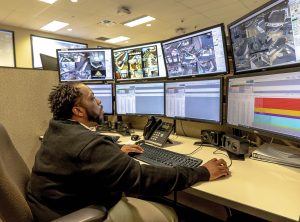— By Matt Smitheman —
Protecting lone workers in a retail or restaurant setting.
As retailers and restaurants continue to revamp their business models to keep pace with customer expectations, many are increasingly relying on lone workers for opening, closing, third shifts, curbside deliveries and other customer interactions outside of the traditional store premises. While lone employees play a critical role in keeping these businesses up and running, they are more at risk of encountering threats at work with an estimated 48% of HR professionals reporting that their organization has witnessed workplace violence.*

Matt Smitheman, Interface Security Systems
Workplace violence and security concerns make talent retention and hiring challenging in a tough labor market. In times like these, more attention needs to be placed on increasing safety measures for lone employees. Security professionals are looking at ways in which they can add another layer of protection for their associates when they are working alone, for locations with limited or no existing protection, or when they need to expand security coverage outside a business’ building.
Developing a Lone Worker Safety Policy
As a first step, asset protection and risk professionals should put in place a comprehensive lone worker safety policy and align with innovative solution providers to leverage technology and training to protect employees and assets.
When rolling out a lone worker safety policy, consider identifying the purpose of the policy and how it aligns with the overall safety culture of the organization. A lone worker policy should clearly communicate the risks presented when an employee works alone. It should identify the responsibilities of each person in this situation and describe the required actions intended to minimize those risks.
The policy should define standard operating procedures (SOPs) and cover the training of employees to develop the understanding and skills required in their job roles. For example, SOPs could include wearing a company-issued safety device, ensuring all lights are working, making sure cameras are operational, and not taking the trash out after 5p.m.
All new hires and existing full-time and part-time employees should be made aware of the procedures through a combination of training programs, role-plays and drills. The objective of the training program should go beyond compliance and focus on business outcomes in terms of safety metrics such as the number of serious incidents, compliance with SOPs, and attrition rate in risky work locations.
Most importantly, the policy should include a synopsis of the right security technologies to be deployed and an emergency communication plan that all employees should know how to utilize should anyone feel threatened.
Lone Workers Don’t Have to be Completely Alone
While many businesses have an alarm or a video security system in place, many were not installed with current working conditions in mind. For example, curbside delivery areas will now need comprehensive security camera coverage. Multi-location businesses should also consider deploying specialized lone worker safety solutions that go beyond simple video surveillance.
Here are two key technology solutions that businesses should consider when planning a comprehensive lone worker safety strategy:
Interactive Remote Video Monitoring Solution
An interactive remote monitoring solution with video and two-way audio capabilities enables trained security staff to see, hear and communicate with employees to ensure their personal safety and make sure the premises remain secure 24/7. Virtual guard services connect to live audio and video feeds remotely and scan the location to look for any potential threat throughout the day and night.
 One of the most vulnerable situations employees may face is when they open or close the office location or store early in the day or late at the night. By retaining the services of a remote security monitoring organization, restaurants and retailers can rely on trained intervention specialists to be on the scene with live audio and video to ensure their team members arrive and depart safely.
One of the most vulnerable situations employees may face is when they open or close the office location or store early in the day or late at the night. By retaining the services of a remote security monitoring organization, restaurants and retailers can rely on trained intervention specialists to be on the scene with live audio and video to ensure their team members arrive and depart safely.
This powerful layer of security ensures there is a security presence on hand and warns potential bad actors that there are eyes on the location. In the event of a threat, employees can rely on the immediate response of a trained, live professional who will properly assess the situation and walk the employee through the appropriate steps of how to safely address the situation.
Wearable Personal Protection Monitoring Solution
While app-based and wearable safety devices have been in use for a long time, the security challenges faced by mobile and lone workers in a consumer-facing, multi-location business cannot be met with off-the-shelf apps and devices.
 When providing realistic options to lone workers, it’s important that any solution be simple and robust enough that employees will see the value and choose to use it. A safety device with a single-push panic button that can be worn discreetly and accessed easily can help a lone worker in a difficult situation without the need to fumble with a smartphone app.
When providing realistic options to lone workers, it’s important that any solution be simple and robust enough that employees will see the value and choose to use it. A safety device with a single-push panic button that can be worn discreetly and accessed easily can help a lone worker in a difficult situation without the need to fumble with a smartphone app.
Wearable personal protection monitoring solutions can also be directly integrated with interactive 24/7 command & control centers. These wearable personal protection devices can easily be worn on a lanyard, belt, vest, jacket or pants. Unlike phone-based apps that take several steps to engage and can actually escalate a situation if an assailant suspects the victim is calling for help, a dedicated personal safety monitoring device is always on and includes a single-push panic button that silently dispatches police and connects to a live monitoring service in seconds.
A properly designed personal protection device delivers comprehensive situational awareness by sending time and location stamped GPS coordinates to authorities. It also opens a two-way audio communication channel with the employee and captures evidentiary grade photos to provide hard evidence for law enforcement. Being cellular-based, there’s no limit to how far an employee can be from the business which means that it is perfect for curbside delivery, bank runs and even home delivery use cases.
Conclusion
Enterprises need a comprehensive safety monitoring solution to help lone workers tackle dangerous situations at work. In addition to saving lives, a lone worker safety program boosts employee morale and productivity. Technology solutions, remote monitoring services and employee training are critical components in increasing safety measures for employees and customers and should be an essential component of a comprehensive business security strategy.
* Source: SHRM (Society for Human Resource Management) Survey
— Matt Smitheman is senior solutions consultant for Interface Security Systems. Smitheman is a veteran in the security industry and has deep expertise in practical applications of remote video monitoring and integration of security technologies. At Interface, he advises customers across diverse industry segments on their comprehensive security strategies and was responsible for rolling out leading-edge monitoring and personal protection solutions.

